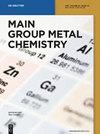M-polynomial-based topological indices of metal-organic networks
IF 1.2
3区 化学
Q3 CHEMISTRY, INORGANIC & NUCLEAR
引用次数: 11
Abstract
Abstract Topological index (TI) is a numerical invariant that helps to understand the natural relationship of the physicochemical properties of a compound in its primary structure. George Polya introduced the idea of counting polynomials in chemical graph theory and Winer made the use of TI in chemical compounds working on the paraffin's boiling point. The literature of the topological indices and counting polynomials of different graphs has grown extremely since that time. Metal-organic network (MON) is a group of different chemical compounds that consist of metal ions and organic ligands to represent unique morphology, excellent chemical stability, large pore volume, and very high surface area. Working on structures, characteristics, and synthesis of various MONs show the importance of these networks with useful applications, such as sensing of different gases, assessment of chemicals, environmental hazard, heterogeneous catalysis, gas and energy storage devices of excellent material, conducting solids, super-capacitors and catalysis for the purification, and separation of different gases. The above-mentioned properties and physical stability of these MONs become a most discussed topic nowadays. In this paper, we calculate the M-polynomials and various TIs based on these polynomials for two different MONs. A comparison among the aforesaid topological indices is also included to represent the better one.基于m -多项式的金属有机网络拓扑指标
摘要拓扑指数(TI)是一种数值不变量,有助于理解化合物在一级结构中物理化学性质的自然关系。George Polya在化学图论中引入了多项式计数的思想,Winer在计算石蜡沸点的化合物中使用了TI。从那时起,关于不同图的拓扑指数和计数多项式的文献发展得非常快。金属有机网络(MON)是一组不同的化合物,由金属离子和有机配体组成,具有独特的形态、优异的化学稳定性、大的孔体积和极高的表面积。对各种MON的结构、特性和合成的研究表明,这些网络具有有用应用的重要性,如不同气体的传感、化学品的评估、环境危害、多相催化、优秀材料的气体和储能装置、导电固体、超级电容器和净化催化,以及不同气体的分离。这些MON的上述性质和物理稳定性成为当今讨论最多的话题。在本文中,我们计算了两个不同MON的M-多项式和基于这些多项式的各种TI。还包括上述拓扑指数之间的比较以表示更好的拓扑指数。
本文章由计算机程序翻译,如有差异,请以英文原文为准。
求助全文
约1分钟内获得全文
求助全文
来源期刊

Main Group Metal Chemistry
CHEMISTRY, INORGANIC & NUCLEAR-CHEMISTRY, ORGANIC
CiteScore
4.10
自引率
27.80%
发文量
21
审稿时长
4 weeks
期刊介绍:
This journal is committed to the publication of short communications, original research, and review articles within the field of main group metal and semi-metal chemistry, Main Group Metal Chemistry is an open-access, peer-reviewed journal that publishes in ongoing way. Papers addressing the theoretical, spectroscopic, mechanistic and synthetic aspects of inorganic, coordination and organometallic main group metal and semi-metal compounds, including zinc, cadmium and mercury are welcome. The journal also publishes studies relating to environmental aspects of these metals, their toxicology, release pathways and fate. Articles on the applications of main group metal chemistry, including in the fields of polymer chemistry, agriculture, electronics and catalysis, are also accepted.
 求助内容:
求助内容: 应助结果提醒方式:
应助结果提醒方式:


